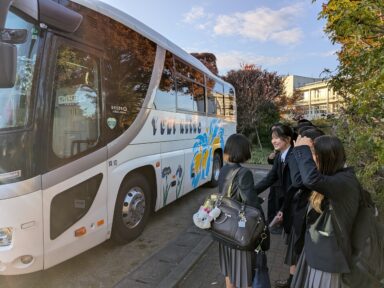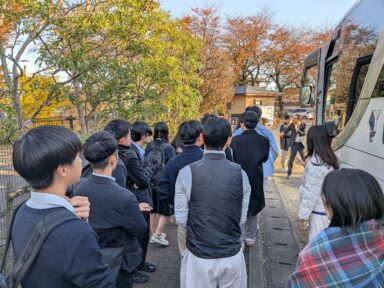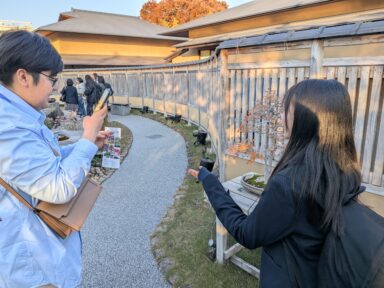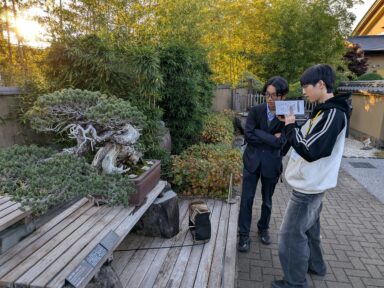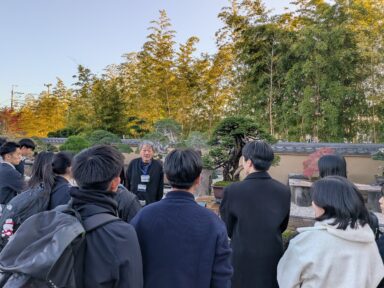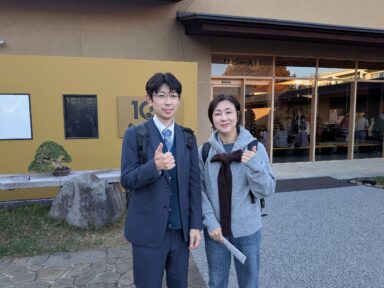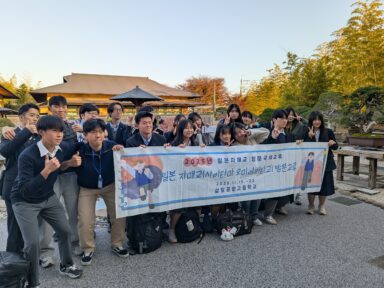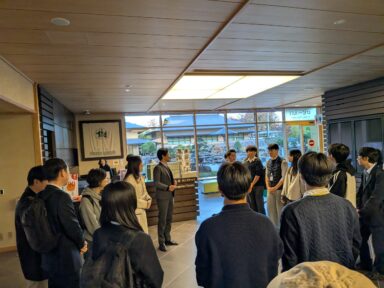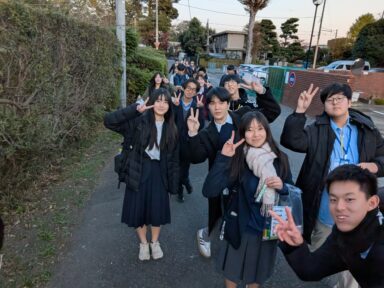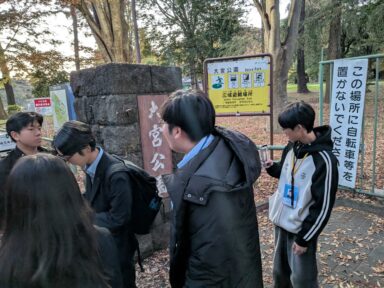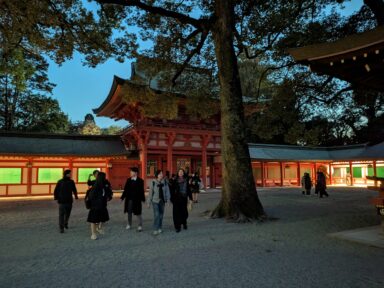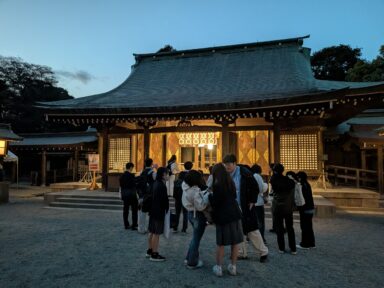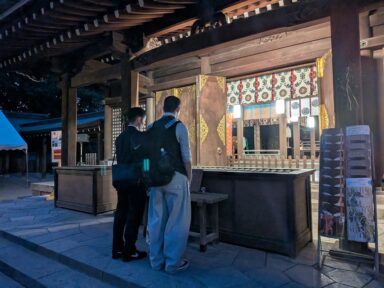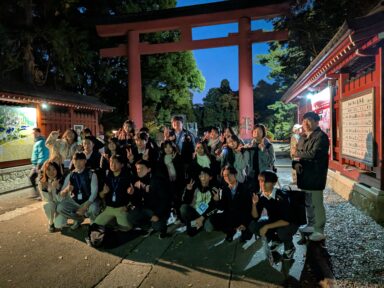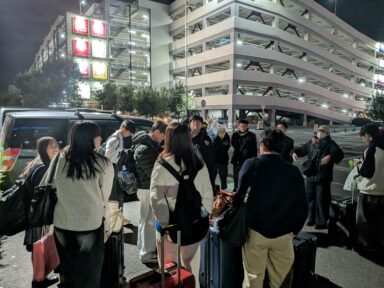ASPnet:日韓姉妹校連携 STHS来校1
Korea-Japan exchange program. Samil Technical High School visited Japan (part1).
本校は韓国のスウォン市にある三一工業高等学校(STHS)と姉妹校連携を行なっています。今回はSTHSの生徒と先生方に来校していただき交流を行いました。
本プロジェクトでは、日韓姉妹校連携大使および大使補佐として、生徒が計画を立て実行することを大切にしてきました。今回も大宮盆栽美術館に下見に行って案内の仕方を考えるなど、生徒たちによる計画です。学校レベルや高校生レベルでできる日韓連携を推進しています。
Our school has established a sister school partnership with Samil Technical High School (STHS) in Suwon, South Korea. This time, students and teachers from STHS visited our school for an exchange program. In this project, we have emphasized having students plan and execute activities as Korea-Japan Sister School Partnership Ambassadors and Assistant Ambassadors. This visit was also planned by the students, including a preliminary visit to the Omiya Bonsai Art Museum to consider how to guide visitors. And devising an exchange program at the school. We are promoting Korea-Japan collaboration at both the school level and the high school student level.
【STHS来校1日目:2025.11.19】
活動内容:韓国(仁川空港)→日本(成田空港)へ移動、成田空港→大宮盆栽美術館へ移動、盆栽鑑賞、武蔵一之宮氷川神社散策、さいたま新都心で夕食、ホームステイ
姉妹校である三一工業高等学校(STHS)より生徒9名と校長先生を含む引率の先生方3名が日本を訪問してくれました。4日間の来日日程のうち2日間を本校との交流に当ててくれています。今回の訪問により相互訪問が実現しました。
1日目は大宮盆栽美術館で盆栽を体験してもらうプログラムと武蔵一之宮氷川神社で日本文化を楽しんでもらうプログラムを実施しました。
まずは、盆栽です。本校が韓国を訪問する際にも大宮盆栽美術館の学芸員・田口文哉様に協力していただきましたが、今回も大宮盆栽美術館全面協力のもと盆栽体験プログラムを実施できました。
事前の下見で学んだことを活かし、本校OKHSの生徒がSTHSの生徒に盆栽の種類や樹齢、鑑賞の仕方などを説明しました。韓国で見られる盆栽は松柏盆栽がほとんどで、雑木盆栽は珍しいとのことで楓などの盆栽に驚いている様子でした。また、樹齢1,000年を超える盆栽の展示もあり、校長先生を始めみなさんにアート作品としての美しさはもちろん、盆栽の持つ生命力や力強さについて楽しんでいただきました。
また、館内の特別展示として県内公立校の生徒が育てた盆栽が飾られていました。本校の生徒が育てたものではないのですが、日本では高校生でも盆栽に親しむ文化があるということに大変関心されており、次回の来日では盆栽づくりの体験もしてみたいと盛り上がっていました。
次に、近くの盆栽園などを見ながら大宮公園へ向かいました。大宮公園の中には武蔵一之宮氷川神社があります。園内の樹木の紅葉を楽しみながら境内にたどり着くと暗くなり始める時間帯ということもあり、神秘的な雰囲気の中で神社の様子を見学することができました。一之宮はその地域で一番格式が高いことを表します。武蔵国で一番格式が高いという氷川神社なので、それなりに参道も長く景色を楽しむことができます。灯籠もところどころにある参道を通り、さいたま新都心コクーンへと向かいました。神社や参道、灯籠などはアニメの一場面にもなることが多いようで、STHSの生徒たちにも雰囲気を楽しんでもらうことができました。
さいたま新都心コクーンでは、日韓姉妹校連携大使からホストファミリーの生徒へバディをバトンタッチし、夕食を一緒に摂りました。それぞれ食べたいものを食べ、ショッピングモールでの買い物を楽しんでもらいました。解散前の再集合では、ラーメン、串カツなどを一緒に食べ、日本と韓国の食文化についていろいろと話ができた様子を見ることができました。ショッピングモールそのものの作りも韓国と日本で非常に似ているようで、中には同じブランドを見つけたり、日本にしかないショップで買い物を楽しんだりしている様子でした。
<生徒感想より>
日本文化の体験として用意してきた「盆栽」「神社」が喜んでもらえるものになってよかった。自分たちが韓国を訪問したときにたくさんもてなしてもらったので、今回は日本でおもてなしができてよかった。日本らしい雰囲気を味わうことができて、日本をもっと好きになった。盆栽はもっと年配の人が行うものだと思っていたが、高校生の育てた盆栽もあると知って驚いた。大宮盆栽美術館から氷川神社に向かう途中に漫画会館という施設があることも知った。日本の漫画文化の発展を知ることができる施設だそうなので、次回はぜひここにも行ってみたいと思った。
【Day 1 in Japan: November 19, 2025】
Activity : South Korea (Incheon Airport) → Japan (Narita Airport), Narita Airport → Omiya Bonsai Art Museum, bonsai viewing, stroll through Musashi Ichinomiya Hikawa Shrine, dinner in Saitama Shintoshin, homestay
Nine students and three accompanying teachers, including the principal, from our sister school, Samil Technical High School (STHS), visited Japan. They dedicated two days of their four-day itinerary to exchange activities with our school. This visit realized the mutual exchange.
On the first day, we conducted a program for participants to experience bonsai at the Omiya Bonsai Art Museum and another program for them to enjoy Japanese culture at Musashi Ichinomiya Hikawa Shrine.
First, the bonsai experience. When our school visited Korea, we also received cooperation from Mr. Fumiya Taguchi, a curator at the Omiya Bonsai Art Museum. This time, with the full cooperation of the Omiya Bonsai Art Museum, we were able to implement the bonsai experience program.
Building on knowledge gained during a prior site visit, our OKHS students explained to STHS students the types of bonsai, their ages, and how to appreciate them. Since bonsai seen in Korea are mostly pine and cypress, deciduous bonsai like maple trees were a surprise and seemed to amaze them. Additionally, the museum displayed bonsai over 1,000 years old. Everyone, including the principal, enjoyed not only the aesthetic beauty as artworks but also the vitality and strength inherent in bonsai.
Additionally, a special exhibition inside the hall featured bonsai cultivated by students from public schools within the prefecture. Although these were not cultivated by our school’s students, the visitors were very interested to learn that in Japan, even high school students have a culture of enjoying bonsai. They were excited, expressing a desire to try their hand at bonsai cultivation during their next visit to Japan.
Next, we headed toward Omiya Park while viewing nearby bonsai gardens. Within Omiya Park stands Musashi Ichinomiya Hikawa Shrine. As we reached the shrine grounds while enjoying the autumn colors of the park’s trees, it was beginning to get dark, allowing us to explore the shrine in a mystical atmosphere. The term “Ichinomiya” signifies the highest-ranked shrine in a region. Being the highest-ranked shrine in Musashi Province, Hikawa Shrine features a correspondingly long approach path where visitors can enjoy the scenery. Passing through the approach lined with lanterns here and there, we headed towards Saitama Shintoshin Cocoon. The shrine, approach, and lanterns often resemble scenes from anime, allowing the STHS students to fully enjoy the atmosphere.
At Saitama Shintoshin Cocoon, the Korea – Japan Sister School Collaboration Ambassadors passed the buddy baton to the host family students, and everyone enjoyed dinner together. Everyone ate what they wanted and enjoyed shopping in the mall. Before dispersing, they gathered again to eat ramen, kushikatsu, and other foods together, and we could see them chatting about various aspects of Japanese and Korean food cultures. The shopping mall itself seemed very similar in layout to those in Korea, and we saw them finding the same brands inside, or enjoying shopping at stores unique to Japan.
<From Student Feedback>
I’m glad the “bonsai” and “shrine” experiences we prepared as Japanese cultural activities were well-received. Since we were so generously hosted when we visited Korea, it felt good to be able to offer hospitality in Japan this time. Experiencing such a quintessentially Japanese atmosphere made me like Japan even more. I thought bonsai was something only older people did, so I was surprised to learn high school students also cultivate them. On the way from the Omiya Bonsai Art Museum to Hikawa Shrine, we also learned about a facility called the Manga Museum. Since it’s a place where you can learn about the development of Japanese manga culture, I definitely want to visit there next time.

